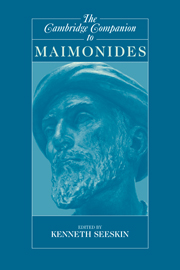Book contents
- Frontmatter
- Introduction
- 1 Moses Maimonides: An Intellectual Portrait
- 2 The Guide and Maimonides’ Philosophical Sources
- 3 Metaphysics and Its Transcendence
- 4 Maimonides’ Epistemology
- 5 Maimonides’ Philosophy of Science
- 6 Maimonides’ Moral Theory
- 7 Maimonides’ Political Philosophy
- 8 Jurisprudence
- 9 Bible Commentary
- 10 Spiritual Life
- 11 Maimonides: Esotericism and Educational Philosophy
- 12 Maimonides--A Guide for Posterity
- Bibliography
- Index
9 - Bible Commentary
Published online by Cambridge University Press: 28 August 2006
- Frontmatter
- Introduction
- 1 Moses Maimonides: An Intellectual Portrait
- 2 The Guide and Maimonides’ Philosophical Sources
- 3 Metaphysics and Its Transcendence
- 4 Maimonides’ Epistemology
- 5 Maimonides’ Philosophy of Science
- 6 Maimonides’ Moral Theory
- 7 Maimonides’ Political Philosophy
- 8 Jurisprudence
- 9 Bible Commentary
- 10 Spiritual Life
- 11 Maimonides: Esotericism and Educational Philosophy
- 12 Maimonides--A Guide for Posterity
- Bibliography
- Index
Summary
Although Maimonides did not write a running commentary on any book of the Bible, biblical exegesis occupies a central place in his writings, especially in the Guide of the Perplexed. In the Introduction to the Guide, Maimonides explains that the book is addressed to a believing Jew who observes the commandments and accepts the Bible as authoritative but has read Aristotelian philosophy and accepts it too. When such people discover contradictions between a literal understanding of the Bible and the principles of philosophy, they become perplexed. Maimonides' exegesis is intended to resolve their perplexity by showing that biblical truth is identical with the truths of philosophy so that one can be a Jew and a philosopher at the same time.
Two assumptions determine the character of Maimonides' exegesis. First he accepts Alfarabi's political theory according to which the ideal state is one whose beliefs are based on philosophy. Religion comes after philosophy and offers educational myths that imitate philosophical truths by images that can be understood by the masses. Second, he considers the Bible an esoteric work that conceals philosophical truth from the masses, allowing them to retain their faith, but reveals it to those who have the requisite degree of knowledge and the capacity to comprehend it. In addition to allowing Maimonides to resolve contradictions between the literal meaning of the biblical text and philosophic truth, these assumptions allow him to explore the philosophic meaning conveyed by educational myths or concealed from the masses by parables and other devices that occur in the Jewish literary tradition.
- Type
- Chapter
- Information
- The Cambridge Companion to Maimonides , pp. 245 - 272Publisher: Cambridge University PressPrint publication year: 2005
- 19
- Cited by



